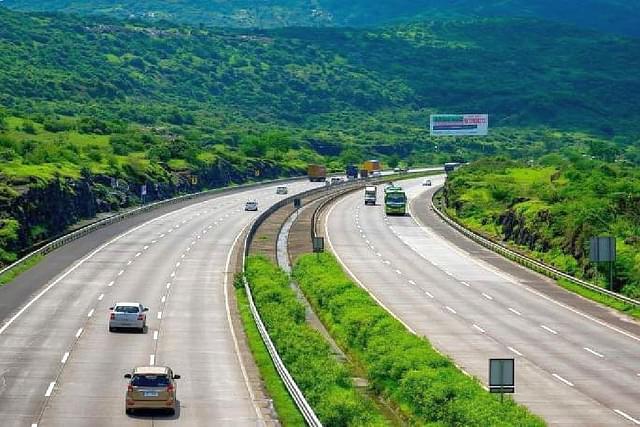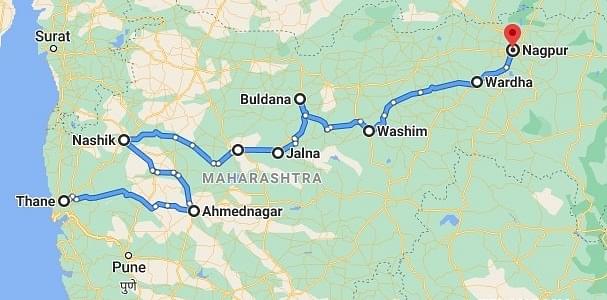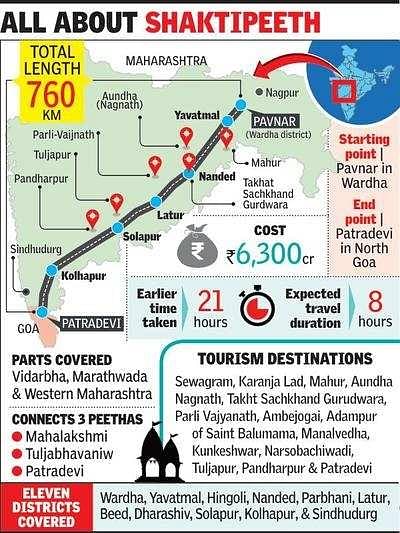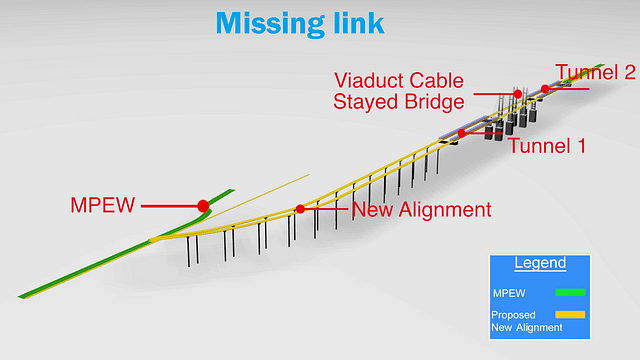Maharashtra is the country’s leading economic powerhouse and will easily be the first Indian state to reach one trillion-dollar Gross State Domestic Product(GSDP).
To support an economy of this size and scale, the state is in the middle of a massive infrastructure development journey implementing a slew of transformational expressways, multimodal corridors, metro systems, coastal roads and other projects.
Shri Radheshyam Mopalwar, the vice chairman and managing director of Maharashtra State Road Development Corporation (MSRDC), is playing an instrumental role in envisaging and executing key infrastructure projects in the state.
Mopalwar is also the Director General Of War Room (Infrastructure Projects) in the Chief Minister’s Office (CMO). The war room was set to push key infrastructure projects in the state and to ensure their completion within a specified time frame. That Mopalwar was handpicked by the state political leadership to head the war room was seen as underscoring the seasoned bureaucrat’s criticality to realising Maharashtra’s infrastructure ambitions.
In an exclusive interview with India Infrahub, Mopalwar spoke about the status of various transformational projects that he is overseeing in his role as the head of MSDRC and as part of the war room, including Mumbai Coastal Road, Mumbai Trans Harbour Link, metro corridors in Mumbai and other cities, expansion of Mumbai Pune expressway, the Mumbai Nagpur Samruddhi Marg, Pune ring road, Thane and Konkan coastal roads and elevated roads.
Slightly edited excerpts of the interview
1) MSRDC was the nodal agency constructing the Samruddhi Expressway, currently the country’s longest expressway. Your spearheaded the project from the very beginning including conceptualising the alignment, land acquisition, securing funding, tendering packages and overseeing the execution. The project is widely regarded as the ‘gold standard’ in greenfield expressway development.
What is the overall vision behind the project especially given that it was just not envisaged as an expressway but as an economic corridor. Also, could you share some complex challenges you encountered and overcame in executing the project?
Mopalwar: To its credit, Maharashtra was the first state in India to develop a greenfield expressway. The construction of the Mumbai-Pune Expressway under the stewardship of the MSRDC began in 1998 and was operationalised in 2002. But after that, there was a lull in building expressways.
We should have capitalised on the head start and connected the rest of the state through a road network but failed to.
In 2015, the BJP-Shiv Sena coalition government announced and approved the construction of a greenfield expressway connecting the state capital, Mumbai, with Nagpur (the state’s second capital located in the easternmost part).
Officially named the Samruddhi Mahamarg, the 701 km Nagpur-Mumbai Expressway covers ten key districts of the state and indirectly connects other 14 districts of the state.
The expressway connects economic hubs including the country’s largest container port, JNPT in Mumbai and a new airport coming up in Navi Mumbai. It will provide access to several industrial and economic centres through 24 interchanges.


Maharashtra’s economic engine continues to be driven by what is described as the ‘golden triangle’ of Mumbai, Pune and Nashik (by some estimates, it accounts for around 60 per cent of the GSDP). Of course, we have Nagpur, which grew on its own organically. Aurangabad also emerged as an industrial hub. We have pockets of industrial growth in Sangli, Satara and Kolhapur. But, the rest of the state, especially the eastern part of Maharashtra, was left out of the development trajectory due to lack of connectivity.
The Nagpur-Mumbai expressway was specifically aimed at opening up new vistas for the state.
The project was not merely envisaged as connecting two places but was envisioned as an economic corridor.
An important vision of the expressway project is to develop 18 townships located at strategic intersections at a distance of 30 to 40 km from each other.
Usually, when a highway is developed, we know that interchanges gradually emerge as economic hotspots. But instead of that process happening in a spasmodic way, we have integrated the township development plan into the expressway project design to unlock the best value.
The new townships will encompass essential facilities including schools, Industrial Training Institutes (ITIs), skill development centres, institutes providing technical education, higher education, hospitals, police stations, playgrounds, open spaces, parks and sports complexes.
With most parts of the expressway now operational, we will soon begin work on the townships
2) Building on the success of Samruddhi Expressway, MSRDC has now embarked on building at least five greenfield expressways crisscrossing the state at an estimated total investment of Rs 3 lakh crore. We want to ask a few questions about it.
RFQ for the proposed Jalna- Nanded expressway connecting Marathwada cities to the Mumbai-Nagpur expressway has evinced keen interest from several firms. What timelines are we looking at for beginning construction on this project?
Mopalwar: Jalna – Nanded Expressway will be around 180 km. It will connect with the Mumbai – Nagpur Expressway and cut down road travel time by four hours, from the existing 10 hours to just six hours. The expressway will also provide easy access to the highway leading to Hyderabad.
The land acquisition is in the final stages. We will have possession of all the land needed for the project in a month or two. We are looking forward to the award of construction contracts by January 2004.
3) The most ambitious greenfield expressway the state plans is the Nagpur-Goa Shaktipeeth expressway.MSRDC is pursuing another crucial project under your leadership: the 388 km Konkan Expressway connecting Mumbai- Sindhudurg.
We understand that the Detailed Project Reports (DPR) for these projects are underway. What is your sense of the timeframe for this project to move towards the execution stage?
Mopalwar: No doubt, the Nagpur-Goa expressway design and execution will be a significant challenge. It will traverse 13 districts connecting Vidarbha, Marathwada, and Konkan and will be over 800 km.
Once complete, it would be one of the longest greenfield expressways in the country, along with the Delhi-Mumbai and Samruddhi Expressways.
The expressway will connect Shakti Peethas and other important religious places like Mahur, Tuljapur, Kolhapur, and Ambejogai which are famous for Devi temples like Mahalaxmi, Tulja Bhavani, Renuka Mata, Patradevi and others.
It will also link to the under-construction Surat-Chennai Economic Corridor by NHAI. The expressway will lead up to the new Goa airport in Mopa.
As you mentioned, we are also working on the Konkan Expressway connecting Mumbai- Sindhudurg.
The two proposed expressways will almost cover the entire southeastern flank of the state. That the state will soon have such a level of connectivity was unimaginable even in a few years.
The alignments for the projects have been finalised. We plan to notify the land acquisition shortly and are confident of completing it quickly.

4) Maharashtra’s innate strength as India’s economic engine (largest GSDP among states) provides it with a certain level of financial depth to fund infrastructure projects. But given spiralling land acquisition costs, the funding of infrastructure projects is a challenging issue. How is the state addressing this issue?
Mopalwar: Land acquisition continues to be the biggest challenge in our projects.
For instance, take the Virar-Alibaug multi-modal corridor. The land costs are very high given that it is in the vicinity of Mumbai. But the land costs become slightly more reasonable if we go to the countryside.
Due to the Land Acquisition Act 2013 provisions, land costs have gone up four times, and in Maharashtra, we pay an additional 25 per cent to the consenting landowners. So, the land that needs to be acquired is already five times the existing market value.
Regarding funding the expressway, we use an existing infrastructure asset as a seed for the next project.
For funding the Mumbai-Nagpur expressway, under the leadership of the then Chief Minister (Devendra Fadnavis), we leveraged the balance sheet of five state public agencies, including Mumbai Metropolitan Region Development Authority (MMRDA), City and Industrial Development Corporation (Cidco), Maharashtra Housing and Area Development Authority (Mhada), Maharashtra Industrial Development Corporation (MIDC) and Slum Rehabilitation Authority (SRA) and raised Rs 5000 crores for land acquisition costs. MSRDC pitched in with Rs 2500 crores.
We also securitised the toll collection rights of the Mumbai-Pune Expressway and the old Mumbai-Pune Highway to fund the Mumbai-Nagpur Expressway. The Rs 9000 crores raised via this route was ploughed to fund the Mumbai-Nagpur Expressway.
While the responsibility for funding land acquisition costs is with MSRDC, the entire construction cost is through loans. The loan for the construction cost is repaid through the toll.
We estimate that in the next two to three years, the state will earn Rs 40,000 crore from the securitisation of rights of the Mumbai-Nagpur Samruddhi Expressway with a 20-25-year concession period.
The funding raised via securitisation will help us acquire land for the proposed expressway. There will definitely be some stress in funding the new projects, but budgetary support from the state and bridge loans can help us tide over it.
The land acquisition payments must be made upfront over one to two years, but the monetisation opportunities comes much later.
For instance, we cannot monetise the Mumbai-Nagpur Expressway immediately as the traffic needs stabilisation(around 600 km of the expressway is operational, and the remaining 100 km will be opened before March 2024). Also, the real value for the Mumbai-Nagpur Expressway will be unlocked when the 92 km Virar-JNPT spur of the Delhi-Mumbai Expressway opens.
5) MSRDC hopes to complete another major project soon: the ‘missing link’ of the Mumbai-Pune Expressway. The project is a complex and, indeed, an engineering marvel. Are you hoping to open it by the end of this year?
Mopalwar: We are confident of completing the ‘missing link’ project on the Mumbai-Pune expressway by June 2024 ( eight months now). The tunnelling work is complete, and some work on viaducts is pending.
The project is indeed an engineering marvel. The ‘missing link’ will feature an 840-metres-long viaduct (60 metres height), then it enters a 1.75-km-long tunnel, then goes over the 640-metres-long cable-stayed bridge (around 100 ft height) and after that enters another 8.9 km-long tunnel.

The cable-stayed bridge is a crucial part of the project. We have designed it to withstand wind speeds of 70 metres per second or 252 km per hour. A prototype of the bridge’s design was put to wind tunnel testing in Denmark, California, Delhi, and Hyderabad. It was a huge effort.
The wind tunnel testing had to be done as the bridge over the Sahyadri Valley. The valley has unique weather patterns with varying wind patterns.
The main carriageway of the Mumbai-Pune Expressway is also currently saturated. And we are planning to expand it from six lanes to ten lanes.
6) Another important urban infrastructure project that MSRDC is pursuing Is the Pune Ring Road, a planned 4-6 lane access-controlled highway that will encircle the city. The project has faced land acquisition challenges and delays.
What is the current status of the project? Also, can you provide some insights on design considerations for the proposed ring road, given that Pune is a continuously and rapidly expanding metropolis?
Mopalwar: A Ring Road is an essential requirement for the Pune metropolitan region. The city must be expanded as it is grappling with congestion, with over 1,25,000 Passenger Car Units(PCUs) and a minimum of 75,000 vehicles entering the city. The city is a manufacturing hub with a strong IT/software services presence.
The 173 km Ring Road project will split the city and the highway traffic and help ease traffic and reduce vehicular pollution.
As far as the progress goes, we are confident of entering the award stage soon. The district collector has promised to deliver the entire land required for the project by December 2023. We have already distributed over 20 per cent of the estimated compensation towards acquiring 125 acres for the project.
MSRDC begins execution of the project after it takes possession of 90 per cent of the land required and the remaining 10 per cent to be delivered in 2-3 months
In April, MSRDC invited the RFQ to select a list of qualified contractors who would participate in the actual bidding process for the project.
7) MSRDC is working on a multi-modal corridor between Virar and Alibaug, another game-changing project. What is the current status of this project?
Mopalwar: The planned 126 km Alibaug-Virar Multi-Modal Corridor is a critical project for us as it will open new vistas of development in the Mumbai region.
The Multi-Modal Corridor will be an essential step towards development as it strengths new growth centres in the Mumbai Metropolitan region, such as Virar, Bhiwandi, Kalyan, Dombivali, Panvel, Taloja and Uran.
The Corridor will be a significant economic driver as it will link to Navi Mumbai International Airport, JNPT Port, Mumbai Trans Harbour Bridge (MTHL) and the Dedicated Freight Corridor.
The real challenge for the project is the land acquisition cost. We are looking at Rs 22,000 crores just for the land acquisition of 98-100 km first phase of the project (almost works out to Rs 200-250 crores per km).
The costs are high since it is conceptualised as a multi-modal corridor and designed to accommodate metro lines. The costs would have been far lower if we had designed it only as an expressway.
8) You are also the Director General (DG) of the Maharashtra infrastructure war room that directly works under the oversight of the state Chief Minister Eknath Shinde to expedite infrastructure projects in the state. We understand that it has dramatically accelerated many projects in the state especially long languishing ones like Mumbai Coastal Road, Mumbai Trans Harbour Link, multiple lines of metro in Mumbai eyc.
Can you share some insights on the operating model of the war room?
Mopalwar: The infrastructure’ war room’ was first established in 2015 by the then Chief Minister Devendra Fadnavis to push key infrastructure projects in the state and ensure their completion within a set timeframe.
The ‘war room’ helped accelerate several projects languishing for years.
In the earlier scheme of things, even minor issues (like a dispute over a small piece of land) could bring major projects to a grinding halt.
Add to the inter-agency coordination challenges. For instance, to construct metro lines in Mumbai, 17 agencies need to interact. Each agency has its own work culture, decision-making styles, etc.
The way the war room was first envisaged in 2015, and later, when it was formalised through an order, the minutes of the war room are the orders of the government. Separate departmental orders are not required to be issued, which expedites the projects’ pace.
The challenges to many projects would not have been addressed if we had gone by the normal, traditional method of departmental decision-making. It just doesn’t work.
During the war room meetings, the project proponents list the issues they are not in a position to address themselves. We have honourable Chief Minister and senior secretaries of the government, including the Chief Secretary, who hold detailed deliberation and make decisions. The basic idea is to provide time-bound solutions to overcome project-related challenges.
The war room has played a pivotal role in fast-tracking various infrastructure projects over the past several years, including the Mumbai metro lines, Mumbai Trans-Harbour Link, Dedicated Freight Corridor, Bullet Train, Mumbai Coastal Road, Samruddhi Expressway, Redevelopment of BDD chawls, Dharavi Slum Redevelopment, Bandra Colony Redevelopment.
9) Mumbai is definitely going through its biggest infrastructure upgrade with ongoing construction of multiple metro lines, Mumbai Trans Harbour Link, Coastal Road, Sea Links etc. But this also means lot of traffic diversions, longer commutes etc which affects life of common people. Also some project tends to get delayed which adds to the overall angst.
What will be best way to communicate to the general public the importance of infrastructure projects given that payoffs are over several years but the pain is immediate
Mopalwar: I agree that infrastructure projects cause short-term pain but it does deliver long-term benefits.
I would like to recall that between 1996 and 1999 period ( under the first Shiv Sena-BJP coalition government), the state constructed over 55 flyovers and bridges in Mumbai, significantly reducing the city’s traffic problems at that time. Before that, Mumbai hardly had any flyovers except for a few, like the one in Peddar Road.
For instance, the JJ flyover, a 2.1 km flyover connecting J.J. Hospital to CST Mumbai. During the project’s construction, I used to remember that some people cursed us for the disruption the work was causing. It was such an intricately designed project passing through the thickly populated zone of the city. The flyover now is a major source of relief to commuters.
Once the multiple lines of the metro are commissioned over the next two to three years, it will dramatically reshape the transport infrastructure landscape of the city. The ease of travel the metro system will offer citizens will be unprecedented.
The suburban rail network currently has three distinct lines (western, central and harbour) operating on exclusive parallel tracks. But multiple metro lines will crisscross the entire length and breadth of the city.
Not many would have imagined even a few years back that areas like Siddhivinayak, Sewri, and many parts of the city would be connected via an extensive metro network, but it will be a reality soon.
10) India is in the middle of its greatest infrastructure upgrade. To successfully execute this, we need serious state capacity in managing projects. As an accomplished bureaucrat who has delivered on several infrastructure projects, does our state apparatus have the requisite capacity? Do we need a specialised cadre for managing infrastructure projects?
Mopalwar: Given the kind of governance model we have signed up for, this is a real challenge.
We have a bureaucracy, which is a generalised bureaucracy. We only have a few specialists with expertise in infrastructure execution.
During my stint as the state Public Health Engineering department head, i once met a CEO of a private company we were engaging. I found out that he was from a finance background and had no engineering or project management experience. Whether it is a public or private enterprise, leadership needs to draw from an eclectic mix.
We also need to understand that state infrastructure projects are not just engineering projects but have huge social ramifications. Bureaucrats have an advantage on this score as they bring a deeper understanding of societal issues. Brownfield projects in urban settings especially come up with tough challenges, and we need sensitive communication by the state to manage them.
In many ways, all developmental initiatives, including infrastructure, is a political process.
It would also be a mistake to limit our understanding of infrastructure. In fact, the biggest chunk of spending is on social infrastructure projects in areas like irrigation, sewerage, water supply, public health, sanitation, housing, energy, etc.
Take housing, for instance. Over 90 per cent of projects in this area are social housing for low-income people by government agencies.
I personally feel that bureaucrats with a flair for execution can be utilised for managing public infrastructure projects and encouraged to stay the course.
I can certainly say that we have much better state capacity in the infrastructure domain than it was ever in the past. Many young and promising officers are focussing on this area and are inclined to take up the challenges.
Thank you so much Shri Moplawar. We wish you success in all your endeavours.


